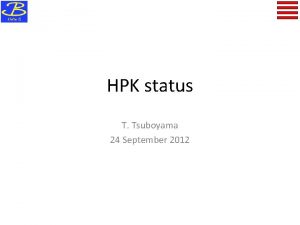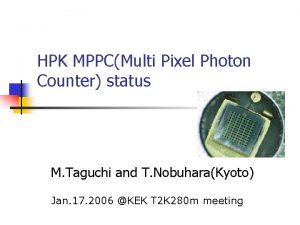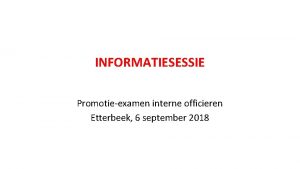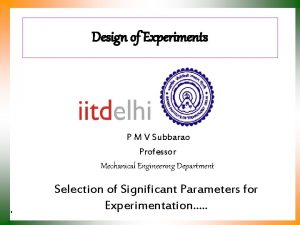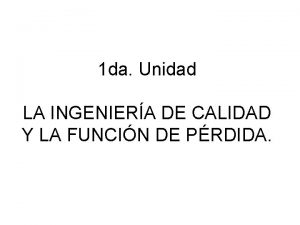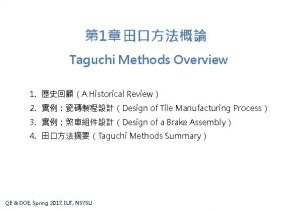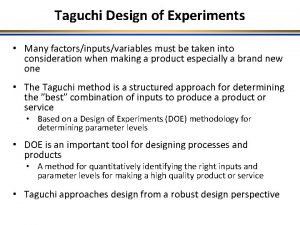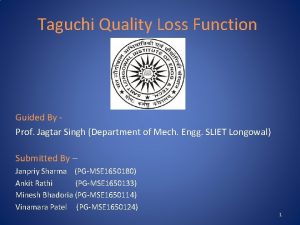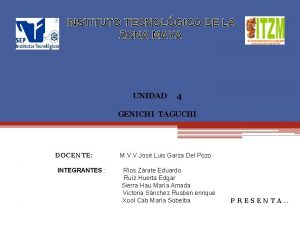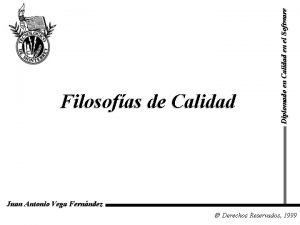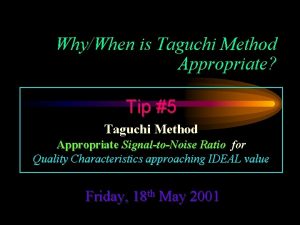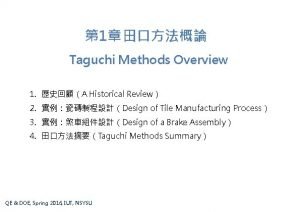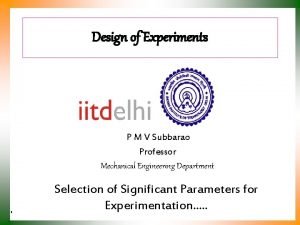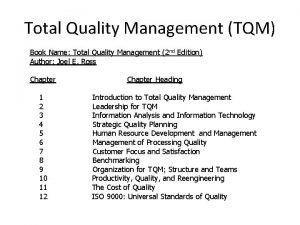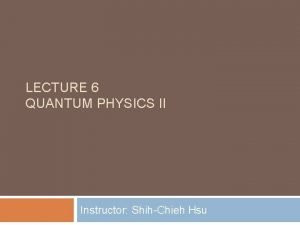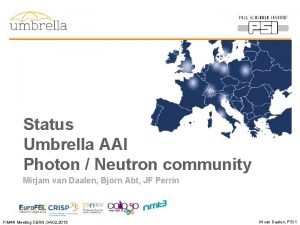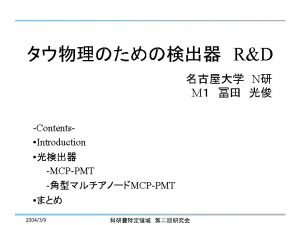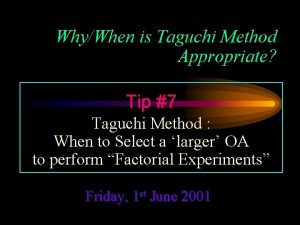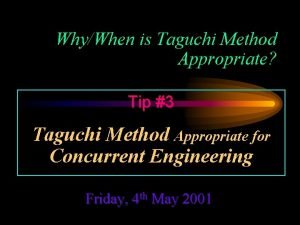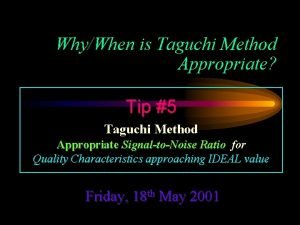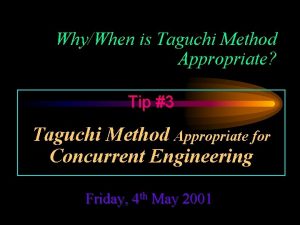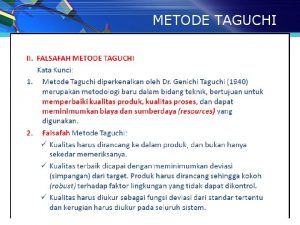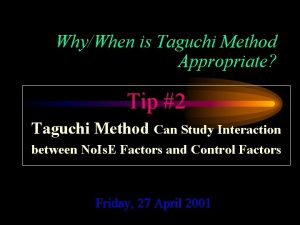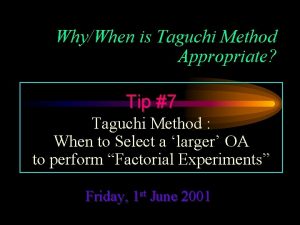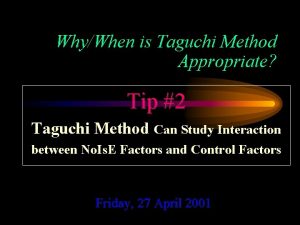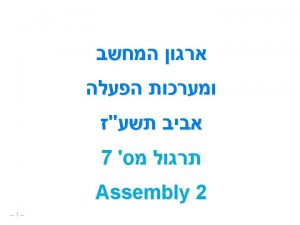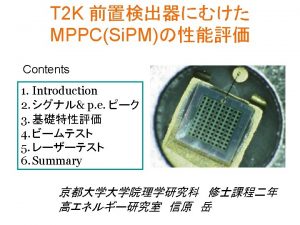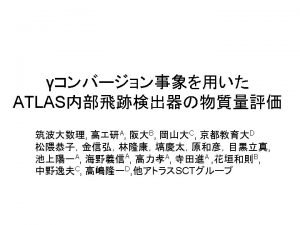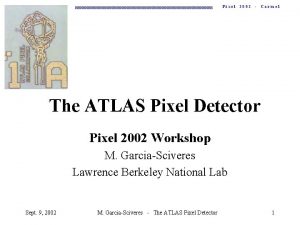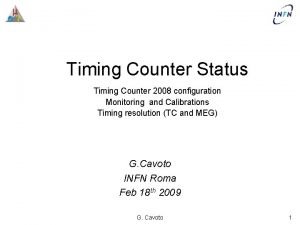HPK MPPCMulti Pixel Photon Counter status M Taguchi



























- Slides: 27

HPK MPPC(Multi Pixel Photon Counter) status M. Taguchi and T. Nobuhara(Kyoto) Jan. 17. 2006 @KEK T 2 K 280 m meeting

Test Procedure ・ Observe the raw signal ・ Confirm the fundamental performance Already presented at the ・ gain previous 280 m meeting ・ noise rate ・ crosstalk Talk at this meeting ・ PDE(photo detection efficiency) ・ Linearity ・ Confirm the performance under the real experimental environment - scintillator+WLS fiber+MPPC ・ Laser Test (using BELLE laser system)

MPPC type used in each measurement MPPC or Russian Si. PM type Crosstalk HPK 100 pixel HPK 400 pixel PDE HPK 100 pixel Linearity HPK 100 pixel Beamtest HPK 100 pixel Russian 600 pixel Laser test HPK 100 pixel We studied the property of HPK 100 pixel type in detail because we used this type of MPPC in beamtest

Crosstalk measurement Crosstalk‥ photons emitted from one pixel during the Geiger discharge causes the Geiger discharge at neighboring pixels ・Assuming 2 p. e noise is caused by crosstalk of 1 p. e noise(accidental coincidence of 1 p. e noise is negligible) Crosstalk rate = Maximum crosstalk rate is 0. 16(HPK 100) and Crosstalk rate 0. 25(HPK 400) 0. 16 0. 25 Data taken by random trigger HPK 100 103 0. 10 102 0. 1 10 0. 5 p. e 1. 5 p. e 70. 3 295 70. 7 71. 0 448 567 760 HPK 400 48. 5 49. 0 49. 3 74 234 478 49. 6 (V) 800 (k. Hz)

PDE(photon detection efficiency) ・PDE(photon detection efficiency) is defined as the ratio of the number of output p. e to the number of injected photons PDE=εpixel×QE×εGeiger A ratio of active area to total area (30%~70%) Depending on MPPC type Quantum efficiency of active area (60~80%) Depending on wavelength of injected light Probability of Geiger discharge (60~80%) Depending on bias V Measured the relative PDE to that of PMT with the following set up (about four HPK 100 MPPCs)

PDE measurement ・only the light going through ½ inch PMT 1 mmφslit is detected WLS fiber The view from this side Blue LED MPPC(total area 1 mm 2) 1 mmφslit Y ・Scan the MPPC and PMT with moving stage and search the position with maximum light yield ・The ratio of MPPC p. e to PMT p. e is taken as relative PDE of MPPC to that of PMT ・ change MPPC bias V MPPC PMT slit x ・ light sources are blue LED and wavelength shifting fiber(Y 11)

PDE measurement(cont’d) Measure PDE at this point PDE(MPPC)/ PDE(PMT) HPK 100#14 green 2 mm MPPC X scan × 1. 4 blue 2 mm MPPC Y scan ・The width of scan is 2 mm 70. 3 70. 5 294 388 ・The max green PDE is about 1. 4 times larger than that of PMT and green PDE is larger than blue PDE 70. 8 524 71. 1 Bias V(V) 687 Noise rate(k. Hz)

PDE measurement(cont’d) ・There is a distance(~0. 8 mm) between surface cover and active area in HPK’s MPPC ・so PDE should decrease effectively when using a WLS fiber because light from a WLS 1 mm fiber spreads at 40° ½ inch PMT Blue LED WLS fiber(1 mmφ) MPPC(total area 1 mm 2) ~0. 8 mm 40° ・Measured the effective PDE with this set up about four HPK 100 e MPPCs(the method of measurement is the same as before) ・compare the PDE measured in the previous measurement

PDE measurement(cont’d) PDE(MPPC) /PDE(PMT) HPK 100#14 54% PDE 3 mm MPPC X scan 3 mm MPPC Y scan ・The width of scan becomes 3 mm due to spread of light from a WLS fiber ・The decrease of PDE due to spread of light from a WLSF is 40~50% about four HPK 100 MPPCs Effective PDE can be increased by improvement of packaging Effective PDE 70. 5 70. 8 71. 1 388 524 687 71. 3 Bias V(V) 864 Noise rate(k. Hz)

Linearity measurement(HPK 100 PMT(1/2 inch PMT) ・ inject uniform light from blue LED uniform light Blue LED MPPC (HPK 100) Set up to PMT and MPPC ・monitor the light injected to MPPC by PMT ・examine the linearity of MPPC output against PMT output ・ linearity depends on the crosstalk rate and the number of pixels, so we measured the linearity at the point that crosstalk rate is 0. 03 and 0. 2

Linearity measurement(cont’d) Fired pixel number Crosstalk rate 0. 03 Difference from the linear extrapolation 10% Theoretical curve calculated with the crosstalk rate and the number of pixels 20% ・data points agree well with theoretical curve 50 p. e Fired pixel ・HPK 100(100 pixel) number showed 20% from nonlinearity when Difference the linear 35~50 p. e are injected (depending on crosstalk rate) Crosstalk rate 0. 2 extrapolation injected p. e 10% 20% injected p. e 35 p. e injected p. e

Beamtest @KEK in Nov. 2005 Motivation ・Can the light yield for T 2 K near detector be obtained? • 0. 5~ 1. 4 Ge. V/c • proton & pion • ~ 100 event/spill • beam size 1 x 1 cm 2 beam setup 64 ch MAPMT (as reference) (more than 5 p. e for MIP) HPK 100 e or Russian Si. PM 4 layers 1 mmΦ fiber Scintillator 1. 3 x 2. 5 x 50 cm 3 (used in K 2 K scibar detector)

Alignment of fiber ・The X Y position of active area of HPK’s MPPC is different by each sample, so alignment of fiber is necessary by each sample X Y MPPC ・Scan the fiber with moving stage and fix the fiber with screws at the point where MPPC signal becomes maximum screw for fixing fiber About 20% loss of light yield is possible due to misalignment of fiber

Beamtest@KEK(cont’d) MPPC type MPPC p. e for MIP PMT p. e for MIP Ratio of MPPC p. e with PMT(%) HPK 100#13 9. 9 18. 3 54 HPK 100#14 10. 2 18. 2 56 HPK 100#16 We 73 could 13. 3 obtain the light 18. 2 yield for T 2 K near detector 22. 9 Russian 600#13 18. 2 126 Russian 600#14 17. 1 18. 2 94 ・The measured PDE including optical contact for HPK 100 and Russian Si. PM are about 0. 7 and 1. 0 of PMT, so obtained light yield is consistent with the expectation considering the misalignment of a fiber

Laser test(HPK 100) ・study the response of each pixel of MPPC Laser source λ=825 nm width 50 ps Feed back this information to HPK MPPC We studied ・Efficiency distribution within 1 pixel ・Uniformity of gain and efficiency in each pixel 100μm microscope Motivation Picture of microscope Moving stage 1μm pitch (x , y) Laser spot size ≒ 10μm

Efficiency distribution within 1 pixel efficiency 1 pixel 100μm Efficiency flat region of 60μm× 60μm ・Scan the laser in the 10 mm pitch within 1 pixel(total 100 scan) laser 1 p. e. 0 p. e. 100μm Efficiency =Ratio of events more than 0. 5 p. e to total events 0. 5 p. e.

Response of each pixel y ・Inject laser to the center of each pixel and study the response of each pixel Relative gain 1. 06 x Total 100 pixel Relative efficiency 1. 04 Response of each pixel is uniform! RMS/mean=3. 6% RMS/mean=2. 5% 0. 96 0. 92 y x

Summary About HPK 100 pixel MPPC n The green PDE is larger than that of PMT n Light yield for MIP is 10~13 p. e (at the point that noise rate and gain satisfy T 2 K requirement) n Response of each pixel is uniform Show 20% nonlinearity when 35~50 p. e are injected → need more than 200 pixel The loss of light yield due to spread of light from a WLS fiber is 40~50% → can be improved by packaging

supplement

Future plan Test the new samples which recently we got (HPK say these have higher PDE than others) n Study the response of each pixel more in detail with the laser system for MPPC @KEK n

MPPC(Multi pixel photon coutner) MPPC characters: 100~1000 APD pixel in 1 mm 2 n Each pixel operates as Geiger mode (independent of input light) n n n n The output is a sum of all the APD signals Compact Low-cost Insensitive to the magnetic field Low bias voltage : 30~75 V High gain: 105~107

Signal and p. e peak HPK 100 a V=48 V 2 p. e 1 p. e 30 p. e Increasing the injected light ・We can count the peak up to 4 p. e ・the interval between each peak completes by 4%

Summary of gain measuremnt ・T=20° ・Gain=3× 105~2× 107 ・The (d. G/d. V)depends on the capacitance of pixel HPK 100 a RUS#14 RUS#20 RUS#22 35 43 Bias V HPK 100 f HPK 100 d HPK 100 e HPK 400 b Bias V 47 RUS#23 49 HPK 1600 a 70 Bias V 74. 5

Summary of gain measurement ・d. G/d. V depends on capacitance of pixel ・Typical gain 7× 105~ 6× 106 @T=20° gain HPK 100 e 2× 106 gain HPK 400 b 6× 106 70 71 Bias V Russian 5× 105 47. 5 49. 5 Bias V 35 36 Bias V

Summary of noise rate measurement noise rate(Hz) 70 HPK 100 f HPK 100 d HPK 100 e HPK 1600 a bias voltage (V) 74 noise rate (Hz) 106 RUS#14 RUS#20 35 RUS#23 RUS#22 bias voltage (V) 0. 5 p. e threshold by pulse height 0. 5 p. e threshold by charge (in progress) 1. 5 p. e threshold by pulse height 43 @T=20 °

Summary of noise rate measurement ・Maximum noise rate~ a few MHz ・Noise rate increases by an order of magnitude with increasing bias V by 1 V Noise rate (Hz) HPK 100 e Noise rate (Hz) HPK 400 b 106 0. 5 p. e threshold 1. 5 p. e threshold Noise rate (Hz) Russian 106 104 104 70 71 Bias V 48 Bias V 50 35 Bias V 37

P/π separation 1. 2 Ge. V π p 0. 8 Ge. V 1. 0 Ge. V 0. 9 Ge. V 1. 2 Ge. V 1. 0 Ge. V 0. 8 Ge. V P/π separation is possible 0. 7 Ge. V 0. 5 Ge. V 0. 6 Ge. V 0. 5 Ge. V MPPC MAPMT 0. 9 Ge. V 0. 6 Ge. V
 Hpk status
Hpk status Hpk status
Hpk status Pixel counter
Pixel counter Jobpol competentieprofiel
Jobpol competentieprofiel Hpk dalam akreditasi rumah sakit
Hpk dalam akreditasi rumah sakit Standar hpk
Standar hpk Rosenberger hpk
Rosenberger hpk Taguchi array selector
Taguchi array selector Funcion de perdida de taguchi ejemplos
Funcion de perdida de taguchi ejemplos Taguchi
Taguchi Dr. genichi taguchi
Dr. genichi taguchi Dr. genichi taguchi
Dr. genichi taguchi Thomas taguchi
Thomas taguchi Taguchi design of experiments
Taguchi design of experiments Taguchi quality loss function
Taguchi quality loss function Genichi taguchi (1924-2012)
Genichi taguchi (1924-2012) Taguchi concepto de calidad
Taguchi concepto de calidad Smaller the better taguchi
Smaller the better taguchi Genichi taguchi
Genichi taguchi Taguchi loss function definition
Taguchi loss function definition Thomas peters calidad
Thomas peters calidad Taguchi array selector
Taguchi array selector Table de taguchi
Table de taguchi Cause and effect diagram
Cause and effect diagram Taguchi array selector
Taguchi array selector Momentum of the photon
Momentum of the photon Photon neutron
Photon neutron Photon polarization
Photon polarization
